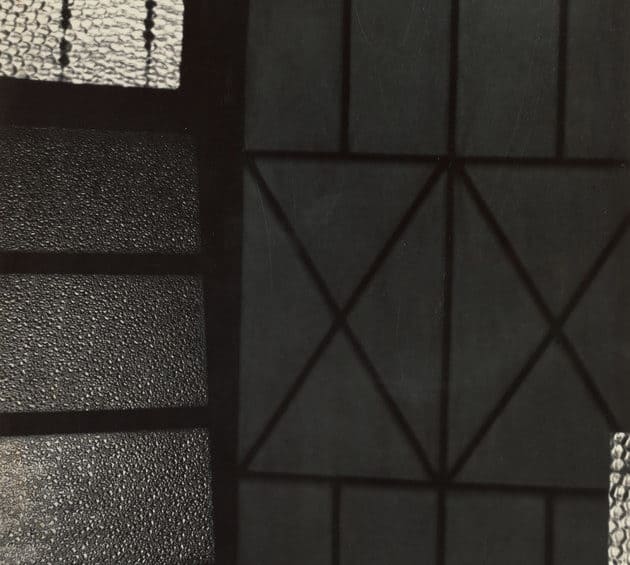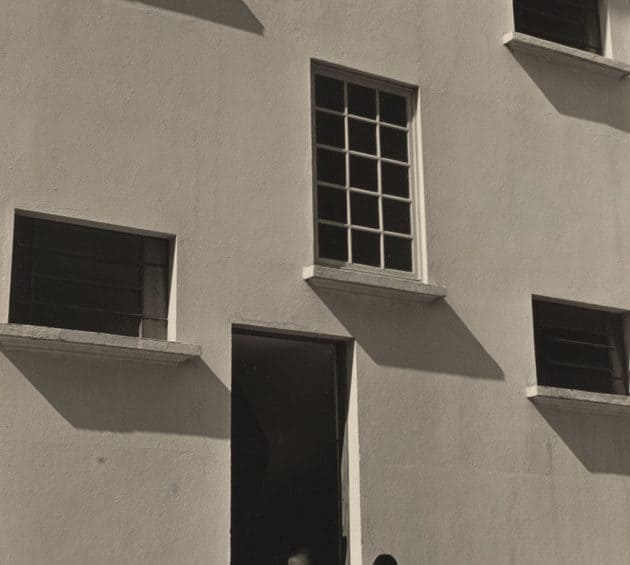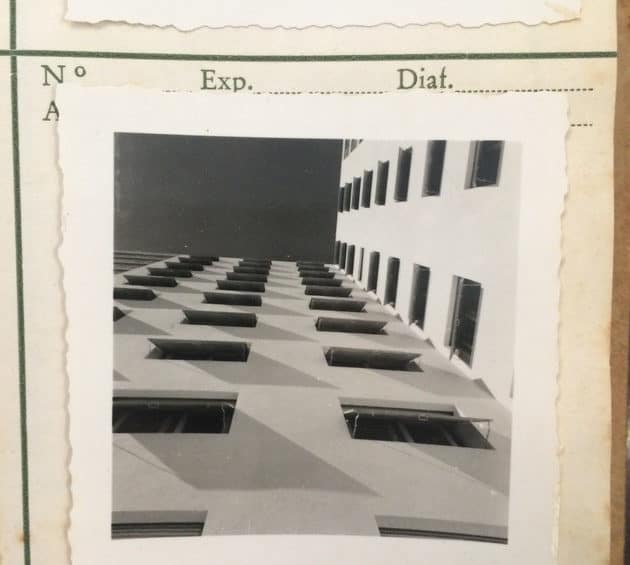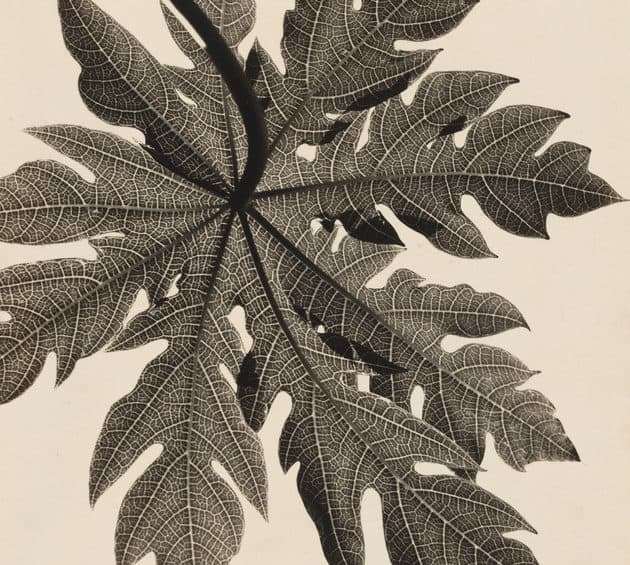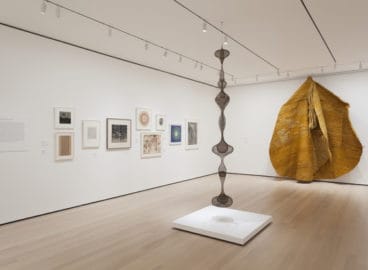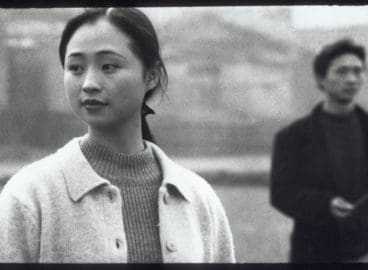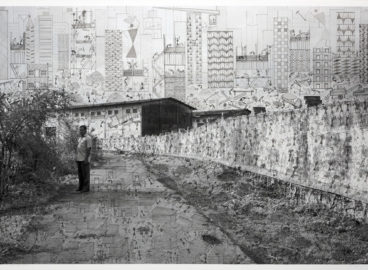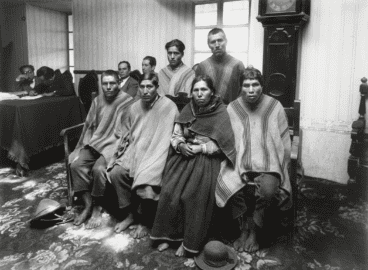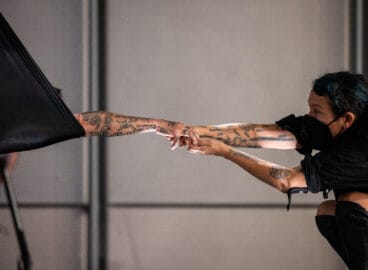This essay considers the condition of Gertrudes Altschul as a German exile who developed a notable photographic practice after settling in Brazil in 1940. Altschul participated in the Foto Cine Clube Bandeirante (FCCB) camera club, contributing to the development of the history of photography in São Paulo through her work. The photographs that she made during her time with the FCCB provide a sense of her perspective as an exiled, modern woman using the camera as a means for self-expression in her adopted country.

For Gertrudes Altschul, a Jewish photographer born in Germany, the journey to Brazil was not uncomplicated, given its inscription in a history of exile. The need to leave Germany in the late 1930s did not come as a surprise given ever more suffocating life conditions for Jewish Germans under the Nazi regime. But with the forced sale of her husband Leon’s business—a ladies’ hat factory—it appeared as the only way forward.1Ernst Altschul, in conversation with the author, São Paulo, February 17, 2016. The couple left Berlin in 1939 and arrived later that year, separately, in São Paulo.2The dates of their journey are indicated as a handwritten annotation in Gertrudes Altschul’s first photo album (1939–52). In 1940, they sent for their son Ernst, who had been living with relatives in the UK for the past two years as a result of the Kindertransport. He traveled to Belem do Pará on a convoy escorted out of European waters by submarines. In 1941, the Altschul family was reunited and settled in São Paulo.3Ernst Altschul, in conversation with the author, São Paulo, February 17, 2016.
Gertrudes’s, Leon’s, and Ernst’s arduous journeys are among the countless trajectories of exile in the 1930s, when Jews and other groups targeted by the Nazis fled Germany as the possibilities for a normal life, at first, and survival, later on, grew slim. Many people fled to South America, and São Paulo in particular received large numbers of immigrants after the Nuremberg laws took effect in Germany in 1935.4German Jews began immigrating to Brazil in great numbers after the Nuremberg Laws took effect in 1935, with immigrant numbers pre-1936 averaging 518 per year, and from 1936 to 1941, 1,312 per year. See Jeff Lesser, Welcoming the Undesirables: Brazil and the Jewish Question (Berkeley: University of California Press, 1995), 77–78. Given the Nazi regime’s explicit targeting of progressive intellectuals and modern artists, many of the German intelligentsia sought refuge abroad, including in São Paulo, having a palpable collective impact on the development of the arts.5The Lithuanian modernist painter Lasar Segall, who immigrated to Brazil in January 1924, is perhaps the most recognized and celebrated. See Edith Wolfe, “‘Exiled from the World’: German Expressionism, Brazilian Modernism, and the Interstitial Kultur,” in Confusão: On Interculturality and German-Brazilian Encounters, eds. Anke Finger, Gabi Kathöfer, and Christopher Larkosh (Berlin and New York: De Gruyter Collection, 2015), 267–99. German photographer Peter Scheier (1908–1979), who immigrated to Brazil in 1937, became a well-respected photojournalist through his work for the Rio de Janeiro–based illustrated magazine O Cruzeiro; he is also known for creating photographic documents of many works of modernist architecture. See “Peter Scheier,” IMS website. In addition, a number of European photographers trained in photojournalism and with a modern aesthetic settled in São Paulo: Hildegard Rosenthal, Pierre Verger, Marcel André Félix Gautherot, Jean Manzon, and Hans Günter Flieg all contributed rich photographs to the Paulista press. Alice Brill and Madalena Schwartz, photographers from Germany and Hungary, respectively, would contribute an extensive archive of documentary and photojournalistic work that represented the growing city and its inhabitants. Schwartz participated in the activities of the FCCB but she did not officially join until 1966, when its modernist period had passed and its photographers had moved on to the more humanistic, documentary style of photography that closely corresponds to her aesthetic. Altschul herself became a photographer in São Paulo when she joined the Foto Cine Clube Bandeirante (FCCB) camera club, contributing through her work to the development of the history of photography in São Paulo.
This article considers the condition of Gertrudes Altschul as an exile who developed a notable photographic practice after settling in Brazil. The fragmentation of her life story by exile makes it difficult to sum up her identity in a few words. Is it more accurate to describe her as a German photographer or a Brazilian one? And how did she identify herself not only in regards to her photographic practice but also beyond it? We do know that she identified as Brazilian according to her inscription form for the FCCB, and that the form does not list her profession, despite the fact that she was actively involved in the family business Arteflor, which produced handmade decorative flowers for women’s hats and blouses.6The Altschul’s home business grew over time to have as many as twenty employees. Altschul photographed its inner workings in candid photographs that are included in her private photo albums.
Beyond the many ways in which conditions of exile upend life stories, “for women, whether artists or writers…the conditions of exile have especially ambiguous or even ambivalent implications,” writes Linda Nochlin. Quoting Janet Wolff, Nochlin continues, “It may be her very identity as woman which enables a radical revision of home and exile.7Janet Wolff, Resident Alien: Feminist Cultural Criticism (Cambridge, UK: Polity, 1995), 7. Quoted in Linda Nochlin, “Art and the Conditions of Exile: Men/Women, Emigration/Expatriation” Poetics Today 17, no. 3 (1996): 318–19. Such revisions could turn out to be, as Wolff writes, “strikingly productive. First, the marginalization entailed in forms of migration can generate new perceptions of place and, in some cases, of the relationship between places. Second, the same dislocation can also facilitate personal transformation, which may take the form of ‘rewriting’ the self, discarding the lifelong habits and practices of a constraining social education and discovering new forms of self-expression.”8Janet Wolff, Resident Alien: Feminist Cultural Criticism (Cambridge, UK: Polity, 1995), 7. I argue that Altschul underwent such a rewriting of the self, and that her photographs, while corresponding to a visual language inherent to the photo-club environment in which she learned, offer interpretive glimpses of the ways in which her position as an exiled woman inflected her way of seeing.
The FCCB, which Altschul joined in 1952, was founded thirteen years earlier, in 1939, by a group of amateur photographers who gathered socially at the counter of Photo Dominadora, a photography and optics shop on Rua São Bento.9Boletim Informativo 24, cited in Raul Feitosa, Bandeirante: 70 anos de história na fotografia (Balneário Camboriú-SC: Editora Photos, 2013), 11. It would change its name to Foto Cine Club Bandeirante (FCCB) after a cinema section was added in 1946. Since the late nineteenth century, camera clubs were formed around the world by practitioners committed to promoting photography as a fine art. Their predominant style became known as pictorialism and was marked by an affinity for soft-focus images that mimic drawing or printmaking, and by an eschewing of the camera as a reproductive or scientific tool. In Brazil, due to rapid industrialization in the late-nineteenth and early twentieth centuries and to the growth of the middle class, the phenomenon of fotoclubismo took hold with particular force, bolstered by a fast-growing industry of photography shops and products that catered to amateurs.10Most regional clubs followed the framework of amateur groups elsewhere, basing their structure on internal competitions and regularly held salons. The earliest known association in Brazil, the Sploro Photo Club, was founded around the turn of the century in the southern city of Porto Alegre. The Photo Clube do Rio de Janeiro, formed in 1910, was short-lived; however, the Photo Club Brasileiro, established in 1923, became an important hub for the amateur photographic community. Angela Magalhães and Nadja Peregrino’s Fotoclubismo no Brasil: O legado da Sociedade fluminense de fotografia (The photo-club movement in Brazil: The legacy of the Fluminense Society of Photography; 2012) focuses on the legacy of a camera club in the Brazilian city of Niterói and underscores the rich fotoclubismo movement in Brazil, with an emphasis on the FCCB’s important position within the network of foto clubes. See Angela Magalhães and Nadja Fonseca Peregrino, Fotoclubismo no Brasil: O legado da Sociedade Fluminense de Fotografia (Rio de Janeiro: Senac Nacional, 2012). Also see Rubens Fernandes Júnior, Papéis efêmeros da fotografia (Fortaleza, CE: Tempo d’Imagem, 2015), 67–105.
In its early years, the FCCB, too, promoted pictorialism as its dominant aesthetic. But by the mid-1940s, changes in the club’s structure—including the internationalization of its salon exhibitions, the implementation of a cinema section, the inclusion of women, and the creation of the Foto Cine Boletim, a regular printed publication—increased the scope of its activities and the ambitions of its members, who sought wider recognition both nationally and abroad. In parallel, a handful of its member-photographers began to experiment with aesthetic propositions that lay decisively outside the purview of pictorialism. The so-called pioneers—Thomaz Farkas, José Yalenti, Geraldo de Barros, and German Lorca—began making images that abandoned the soft-focus and timeless, romantic tableaux of the countryside for a sharper look at form and geometry in the urban environment, as well as exploring other experimental techniques.11These photographers were deemed “pioneers” in Helouise Costa and Renato Rodrigues, A fotografia moderna no Brasil (Rio de Janeiro: Funarte, 1995). By the mid-1950s, the four pioneros would separately leave the FCCB to continue developing their practices without the limitations the organization imposed.



In joining the FCCB in the early 1950s, Gertrudes Altschul would become part of the Escola Paulista (São Paulo school), the group of photographers within the club who followed in the footsteps of some of the pioneros and made pictures with a modernist aesthetic.12The term Escola Paulista was coined by critics writing for specialized magazines at the time to describe the modern production of the FCCB. Costa and Rodrigues reprised the term to denote a subgroup of modernist photographers within the FCCB. In addition to Altschul, its main representatives were Eduardo Salvatore, Marcel Giró, Roberto Yoshida, Ademar Manarini, Gaspar Gasparian, Ivo Ferreira da Silva, and João Bizarro Da Nave Filho. Costa and Rodrigues’s criteria for identifying these main representatives was their prolonged participation in the club and their production of substantial bodies of work. See Helouise Costa and Renato Rodrigues, A fotografia moderna no Brasil (Rio de Janeiro: Funarte, 1995), 59. The relatively new emphasis on vision as opposed to artifice—and on the concept of a photographic “eye”—became so relevant in the 1950s that the category “photographic vision” was added to “composition” and “technique” as a criterion in monthly contests.13Helouise Costa and Renato Rodrigues, A fotografia moderna no Brasil (Rio de Janeiro: Funarte, 1995), 94. Though the photographers in the “pioneer” group developed somewhat different aesthetic approaches from each other, the work of Escola Paulista photographers shares certain visual conventions: a break from classical rules of composition, frequent use of radical chiaroscuro, emphasis on strong lines as compositional elements, abstract forms, and a tendency toward geometric motifs.14Helouise Costa and Renato Rodrigues, A fotografia moderna no Brasil (Rio de Janeiro: Funarte, 1995), 58–59. The authors also emphasize that a “defense of eclecticism” in the Foto Cine Clube in the early 1950s accommodated the modernist photographs of the Escola Paulista but also a wide range of other aesthetic propositions, many of which were of terrible quality. See 68. These similarities may be attributed to the monthly contests, which were often thematic or organized around particular motifs. Several of Altschul’s photographs correspond to these criteria—such as her photographs of stairs and ladders, of construction materials in a barren landscape, and her geometric experiments with camera-less photography—but her interests, like those of many of the fotoclubistas, were wide-ranging. In addition to photographing urban spaces, as others also did, Altschul displayed a sustained interest in photographing plants, and she experimented with different photographic techniques such as photograms and solarizations. Like others in the club, she made pictures of the urban São Paulo landscape. And a number of extant examples suggest that composing still lifes, referred to at the time as “table-tops,” was also a part of her practice.





When Altschul joined the club in 1952, she had had to submit three 3 x 4–inch sample photographs along with an inscription form to pass muster; this suggests that the FCCB members who approved her membership saw promise in her “photographic vision.” Despite her relatively short photographic career—she was a member for ten years, until her death—the quality of her photographs was recognized within the club and further afield. Her prints were frequently included among those mailed out by the FCCB for consideration for salons worldwide, they were often accepted for these exhibitions, and several of them were reproduced within the club’s Foto Cine Boletim.15Other features in the Boletim include her graphically striking photograph Composição (fig. 9), reproduced inside Foto Cine Boletim 9, no. 98 (January–April 1956): 12. Not long thereafter, a closeup of the veins of a leaf, Detras da cortinha, was published in Foto Cine Boletim 9, no. 101 (August–November 1956): 17. Her photograph Filigrana, for instance, was first published in the Boletim in 1952, reproduced opposite a picture by fellow FCCB photographer Ademar Manarini.16Foto Cine Boletim 7, no. 81 (1953): 22. This early publication foreshadowed Altschul’s ongoing preoccupation with the botanical motif of leaves.17Her penchant for botanical photographs also set her work apart from that of her peers since very few FCCB members produced comparably ample explorations of the subject; Ademar Manarini was the only one to make photographs of plants that bear resemblance to those made by Altschul, but his depictions were fewer and more geared toward abstraction. Not only was Altschul the main FCCB photographer to focus on this motif during the 1950s, but also her photographs of leaves were among her most widely circulated works, particularly Filigrana. In 1953 the same photograph was exhibited at a salon in Buenos Aires, and in the Salão Internacional de Arte Fotográfica de São Paulo (International Salon of Photographic Art of São Paulo), alongside three other photographs by Altschul. (A rare photograph of Altschul herself shows the artist posing with two of the four photographs included in this salon, Folha morta and Vasos e plantas).18XII Salão Internacional de Arte Fotografia, Galeria Prestes Maia, São Paulo. See Foto Cine Boletim, special edition, December 1953. Exhibition catalogue. Between 1956 and 1962 Filigrana was submitted to salons throughout Brazil and internationally eighteen times, and accepted for exhibition on eight occasions. It would be reproduced again in 1962, alongside Altschul’s obituary in the Boletim, where it was praised as “one of her first successful works.”19Foto Cine Boletim 11, no. 131 (1962). From 1956–1962, Filigrana was submitted to salons eighteen times and accepted for exhibition on eight occasions, according to the “Relações de Fotografias Enviadas,” archival documents 1956–62, FCCB Archive, Rua Augusta 1108, Consolação, São Paulo.



It is not too hard to imagine why this photograph was compelling in the 1950s and still is today. It depicts an intricate leaf captured against a light, neutral background that emphasizes its unique shape and sharp contours, and foregrounds its latticelike veins, which resemble the view of a city glimpsed from an airplane at night. The flat depiction denies any sense of perspective, aligning the work with one of the visual conventions of the time: underscoring the flatness of the photographic-paper support. Instead of identifying the plant depicted, the photograph’s title refers to the jeweler’s craft of filigree, in which very fine metal threads are bent into complicated designs, suggesting interpretations beyond the object represented in the photograph. The metaphoric title notwithstanding, the clear reproduction allows the identification of the specimen as a Carica papayaleaf, the same plant that produces the popular tropical papaya fruit.20Robert Lee Riffle, The Tropical Look: An Encyclopedia of Dramatic Landscape Plants (Portland, OR: Timber Press, 1998; repr. 1999), 93. Carica papaya leaves are usually an impressive two to three feet in diameter; by filling most of the frame with the leaf, its size is foregrounded.21Robert Lee Riffle, The Tropical Look: An Encyclopedia of Dramatic Landscape Plants (Portland, OR: Timber Press, 1998; repr. 1999), 93. The choice of subject—an autochthonous Brazilian plant that bears a popular tropical fruit—underscores the idea that her identity as an artist was rooted and nurtured in Brazil, an outcome of her exile. It offers an emblematic consideration of this leaf as a stand-in for the exuberant natural environment of her adopted homeland.
In contrast to the focus on plants, Altschul also directed her lens at the city growing around her in ways that suggest an aspect of the exile experience. Though the cityscape was a frequent subject for FCCB photographers, Altschul’s cityscapes distinguish themselves in the way they reveal a sense of play with the codes of vision, rewarding viewers for their close consideration.22With the rise of modernist architecture came also the need and desire to photograph it. Within the FCCB, the covers of the Foto Cine Boletim reflect the popularity of the architectural focus. Out of the fifty issues studied (1952–1962), ten covers reflect urban environments and buildings. The number grows to thirteen if covers alluding to transportation and industry are included. In contrast, there are seven covers (out of fifty) that feature more nostalgic photographs of towns or the rural countryside. No photographs of architectural views made by female photographers were among the reviewed issues of Boletim nor in MASP- FCCB: Coleção Museu de Arte de São Paulo Foto Cine Clube Bandeirante (São Paulo: MASP, 2016). Exhibition catalogue. Linhas e tons is one such example, and it was celebrated by the club by being featured on the cover of the Boletim in 1953.23Foto Cine Boletim 7, no. 84 (1953). The composition reflects a confounding landscape through its juxtapositions of flat architectural shapes and a curved mosaic edge that vertically intersects the frame.

Another cityscape, Arquitetura (Architecture, 1957), similarly conveys disorientation.24Arquitetura is part of a series of FCCB photographs now part of the collection of MASP. It was featured in the exhibition FCCB no MASP, 2016, and reproduced in the accompanying catalogue, MASP- FCCB. Looking upward at three buildings, Altschul found a point of view in which a clear sense of perspective is not available. Arquitetura, according to Helouise Costa and Renato Rodrigues, “reinforce[s] the realism of the photograph appealing to the sense of anguish that we experience when we live through the disorderly growth of our urban centers.”25Costa and Rodrigues, A fotografia moderna no Brasil, 66. Original text: “A artista utiliza a fotomontagem justamente para reforçar o realismo da fotografia, apelando para a sensação de angústia que temos ao vivenciar o desordenado crescimento dos nossos centros urbanos.” In addition to being formally and compositionally seamless, both photographs convey a sense of awe at the upward growth of the city. In these two images, Altschul demonstrates an ability to convey a strong psychological effect within a seemingly simple architectural shot, displaying an economy of means and commenting, despite the lack of geographical specificity, on a fascination with urban forms.26Altschul made a few other upward-looking photographs that appear in her contact sheets, but no known prints were made from those negatives. The sense of disarray of elements in the photographs reflects the idea, described by Edward Said, that “exile is life led outside habitual order. It is nomadic, decentered . . . no sooner does one get accustomed to it than its unsettling force erupts anew.” 27Edward W. Said, Reflections on Exile and Other Essays (Convergences: Inventories of the Present) (Cambridge, MA: Harvard University Press, 2000), 186. The sense of disorientation conveyed in these photographs might reflect some of the “unsettling force” that the experience of exile held for Altschul in gazing up at a city that, if not completely unfamiliar, was rapidly transforming.
Photographs like Arquitetura ou Triângulo ou Composição also underscore the fact that Altschul was a member of a cross-fertile artistic environment. In 1951, just prior to her enrollment in the FCCB, the cover of the Boletim was of architectural elements photographed from below, while the interior featured photographs by Marcel Giró and Kazuo Kawahara of buildings captured from oblique angles.28Abigail Lapin Dardashti, “Gertrudes Altschul and Modernist Photography at the Foto Cine Clube Bandeirante,” MoMA: Features and perspectives on art and culture, posted June 7, 2017, accessed March 26, 2018. Altschul’s composition also closely resembles Thomaz Farkas’s earlier photograph Apartamentos (ca. 1945), in which several buildings also appear to lean into each other. These cityscapes, but especially Altschul’s and Farkas’s, suggest an awareness and attention to the area drawn by the sky not as expansive but rather enclosing. The specter of loneliness evoked in these photographs is underscored by the absence of people—the only nod to habitation is a half-raised blind in the window of a building in Linhas.

Although the photographs discussed here are only a handful of examples in a wider-ranging practice, they focus on some of the aspects that distinguish Altschul’s approach to photography and that can be interpreted as expressing aspects of her experience as a German exile in Brazil. As a result of bone cancer, which befell her in 1958, Altschul mostly stopped making photographs. The sudden decrease in her photographic production is evident in her absence from the FCCB’s Boletim and the catalogues of the São Paulo salons: her work was consistently published in the Boletim and her prints included in the salon exhibitions from 1953 to 1957, but not thereafter.29Altschul’s son, Ernst, confirms that she fell ill and was increasingly debilitated in late 1957, undergoing radiotherapy before her death in 1962. Ernst Altschul, in conversation with the author, São Paulo, February 28, 2016. Her physical absence after 1957 is also confirmed in the General Assembly Attendance Record notebook kept at the FCCB Archive, rua Augusta 1108, Consolação, São Paulo. She signed the record notebook at the assembly meetings in 1953, 1955, and 1957, but not in 1959 and 1961. See attendance book, FCCB Archive. Nonetheless, the work she made during her time with the FCCB allows us to get a sense of her perspective and point of view as an exiled, modern woman using the camera as a means for self-expression in her adopted country. As Nochlin writes, “When it comes to exile, artists would seem to be in a better position than writers. Somehow, the visual world loses less in translation.”30Nochlin, “Art and the Conditions of Exile: Men/Women, Emigration/Expatriation,” Poetics Today 17, no. 3 (1996): 317. The work of Gertrudes Altschul suggests that there was much to gain, and that her point of view—as an exiled Jewish German woman who became a photographer in Brazil—adds nuance and complexity to an effervescent and important moment in the history of Brazilian photography.
- 1Ernst Altschul, in conversation with the author, São Paulo, February 17, 2016.
- 2The dates of their journey are indicated as a handwritten annotation in Gertrudes Altschul’s first photo album (1939–52).
- 3Ernst Altschul, in conversation with the author, São Paulo, February 17, 2016.
- 4German Jews began immigrating to Brazil in great numbers after the Nuremberg Laws took effect in 1935, with immigrant numbers pre-1936 averaging 518 per year, and from 1936 to 1941, 1,312 per year. See Jeff Lesser, Welcoming the Undesirables: Brazil and the Jewish Question (Berkeley: University of California Press, 1995), 77–78.
- 5The Lithuanian modernist painter Lasar Segall, who immigrated to Brazil in January 1924, is perhaps the most recognized and celebrated. See Edith Wolfe, “‘Exiled from the World’: German Expressionism, Brazilian Modernism, and the Interstitial Kultur,” in Confusão: On Interculturality and German-Brazilian Encounters, eds. Anke Finger, Gabi Kathöfer, and Christopher Larkosh (Berlin and New York: De Gruyter Collection, 2015), 267–99. German photographer Peter Scheier (1908–1979), who immigrated to Brazil in 1937, became a well-respected photojournalist through his work for the Rio de Janeiro–based illustrated magazine O Cruzeiro; he is also known for creating photographic documents of many works of modernist architecture. See “Peter Scheier,” IMS website. In addition, a number of European photographers trained in photojournalism and with a modern aesthetic settled in São Paulo: Hildegard Rosenthal, Pierre Verger, Marcel André Félix Gautherot, Jean Manzon, and Hans Günter Flieg all contributed rich photographs to the Paulista press. Alice Brill and Madalena Schwartz, photographers from Germany and Hungary, respectively, would contribute an extensive archive of documentary and photojournalistic work that represented the growing city and its inhabitants. Schwartz participated in the activities of the FCCB but she did not officially join until 1966, when its modernist period had passed and its photographers had moved on to the more humanistic, documentary style of photography that closely corresponds to her aesthetic.
- 6The Altschul’s home business grew over time to have as many as twenty employees. Altschul photographed its inner workings in candid photographs that are included in her private photo albums.
- 7Janet Wolff, Resident Alien: Feminist Cultural Criticism (Cambridge, UK: Polity, 1995), 7. Quoted in Linda Nochlin, “Art and the Conditions of Exile: Men/Women, Emigration/Expatriation” Poetics Today 17, no. 3 (1996): 318–19.
- 8Janet Wolff, Resident Alien: Feminist Cultural Criticism (Cambridge, UK: Polity, 1995), 7.
- 9Boletim Informativo 24, cited in Raul Feitosa, Bandeirante: 70 anos de história na fotografia (Balneário Camboriú-SC: Editora Photos, 2013), 11. It would change its name to Foto Cine Club Bandeirante (FCCB) after a cinema section was added in 1946.
- 10Most regional clubs followed the framework of amateur groups elsewhere, basing their structure on internal competitions and regularly held salons. The earliest known association in Brazil, the Sploro Photo Club, was founded around the turn of the century in the southern city of Porto Alegre. The Photo Clube do Rio de Janeiro, formed in 1910, was short-lived; however, the Photo Club Brasileiro, established in 1923, became an important hub for the amateur photographic community. Angela Magalhães and Nadja Peregrino’s Fotoclubismo no Brasil: O legado da Sociedade fluminense de fotografia (The photo-club movement in Brazil: The legacy of the Fluminense Society of Photography; 2012) focuses on the legacy of a camera club in the Brazilian city of Niterói and underscores the rich fotoclubismo movement in Brazil, with an emphasis on the FCCB’s important position within the network of foto clubes. See Angela Magalhães and Nadja Fonseca Peregrino, Fotoclubismo no Brasil: O legado da Sociedade Fluminense de Fotografia (Rio de Janeiro: Senac Nacional, 2012). Also see Rubens Fernandes Júnior, Papéis efêmeros da fotografia (Fortaleza, CE: Tempo d’Imagem, 2015), 67–105.
- 11These photographers were deemed “pioneers” in Helouise Costa and Renato Rodrigues, A fotografia moderna no Brasil (Rio de Janeiro: Funarte, 1995).
- 12The term Escola Paulista was coined by critics writing for specialized magazines at the time to describe the modern production of the FCCB. Costa and Rodrigues reprised the term to denote a subgroup of modernist photographers within the FCCB. In addition to Altschul, its main representatives were Eduardo Salvatore, Marcel Giró, Roberto Yoshida, Ademar Manarini, Gaspar Gasparian, Ivo Ferreira da Silva, and João Bizarro Da Nave Filho. Costa and Rodrigues’s criteria for identifying these main representatives was their prolonged participation in the club and their production of substantial bodies of work. See Helouise Costa and Renato Rodrigues, A fotografia moderna no Brasil (Rio de Janeiro: Funarte, 1995), 59.
- 13Helouise Costa and Renato Rodrigues, A fotografia moderna no Brasil (Rio de Janeiro: Funarte, 1995), 94.
- 14Helouise Costa and Renato Rodrigues, A fotografia moderna no Brasil (Rio de Janeiro: Funarte, 1995), 58–59. The authors also emphasize that a “defense of eclecticism” in the Foto Cine Clube in the early 1950s accommodated the modernist photographs of the Escola Paulista but also a wide range of other aesthetic propositions, many of which were of terrible quality. See 68.
- 15Other features in the Boletim include her graphically striking photograph Composição (fig. 9), reproduced inside Foto Cine Boletim 9, no. 98 (January–April 1956): 12. Not long thereafter, a closeup of the veins of a leaf, Detras da cortinha, was published in Foto Cine Boletim 9, no. 101 (August–November 1956): 17.
- 16Foto Cine Boletim 7, no. 81 (1953): 22.
- 17Her penchant for botanical photographs also set her work apart from that of her peers since very few FCCB members produced comparably ample explorations of the subject; Ademar Manarini was the only one to make photographs of plants that bear resemblance to those made by Altschul, but his depictions were fewer and more geared toward abstraction. Not only was Altschul the main FCCB photographer to focus on this motif during the 1950s, but also her photographs of leaves were among her most widely circulated works, particularly Filigrana.
- 18XII Salão Internacional de Arte Fotografia, Galeria Prestes Maia, São Paulo. See Foto Cine Boletim, special edition, December 1953. Exhibition catalogue.
- 19Foto Cine Boletim 11, no. 131 (1962). From 1956–1962, Filigrana was submitted to salons eighteen times and accepted for exhibition on eight occasions, according to the “Relações de Fotografias Enviadas,” archival documents 1956–62, FCCB Archive, Rua Augusta 1108, Consolação, São Paulo.
- 20Robert Lee Riffle, The Tropical Look: An Encyclopedia of Dramatic Landscape Plants (Portland, OR: Timber Press, 1998; repr. 1999), 93.
- 21Robert Lee Riffle, The Tropical Look: An Encyclopedia of Dramatic Landscape Plants (Portland, OR: Timber Press, 1998; repr. 1999), 93.
- 22With the rise of modernist architecture came also the need and desire to photograph it. Within the FCCB, the covers of the Foto Cine Boletim reflect the popularity of the architectural focus. Out of the fifty issues studied (1952–1962), ten covers reflect urban environments and buildings. The number grows to thirteen if covers alluding to transportation and industry are included. In contrast, there are seven covers (out of fifty) that feature more nostalgic photographs of towns or the rural countryside. No photographs of architectural views made by female photographers were among the reviewed issues of Boletim nor in MASP- FCCB: Coleção Museu de Arte de São Paulo Foto Cine Clube Bandeirante (São Paulo: MASP, 2016). Exhibition catalogue.
- 23Foto Cine Boletim 7, no. 84 (1953).
- 24Arquitetura is part of a series of FCCB photographs now part of the collection of MASP. It was featured in the exhibition FCCB no MASP, 2016, and reproduced in the accompanying catalogue, MASP- FCCB.
- 25Costa and Rodrigues, A fotografia moderna no Brasil, 66. Original text: “A artista utiliza a fotomontagem justamente para reforçar o realismo da fotografia, apelando para a sensação de angústia que temos ao vivenciar o desordenado crescimento dos nossos centros urbanos.”
- 26Altschul made a few other upward-looking photographs that appear in her contact sheets, but no known prints were made from those negatives.
- 27Edward W. Said, Reflections on Exile and Other Essays (Convergences: Inventories of the Present) (Cambridge, MA: Harvard University Press, 2000), 186.
- 28Abigail Lapin Dardashti, “Gertrudes Altschul and Modernist Photography at the Foto Cine Clube Bandeirante,” MoMA: Features and perspectives on art and culture, posted June 7, 2017, accessed March 26, 2018.
- 29Altschul’s son, Ernst, confirms that she fell ill and was increasingly debilitated in late 1957, undergoing radiotherapy before her death in 1962. Ernst Altschul, in conversation with the author, São Paulo, February 28, 2016. Her physical absence after 1957 is also confirmed in the General Assembly Attendance Record notebook kept at the FCCB Archive, rua Augusta 1108, Consolação, São Paulo. She signed the record notebook at the assembly meetings in 1953, 1955, and 1957, but not in 1959 and 1961. See attendance book, FCCB Archive.
- 30Nochlin, “Art and the Conditions of Exile: Men/Women, Emigration/Expatriation,” Poetics Today 17, no. 3 (1996): 317.
